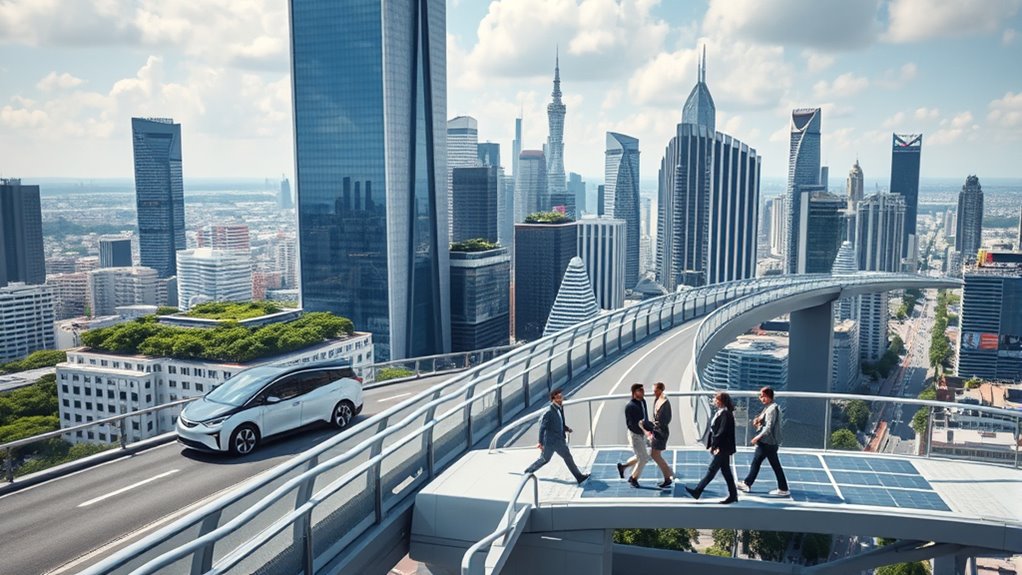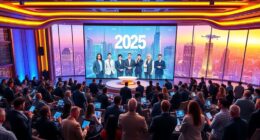By 2025, the auto industry has shifted from traditional manufacturing hubs like Detroit to a Silicon Valley-driven hub focused on innovation. You’ll see more autonomous and electric vehicles, with advanced AI and real-time data making driving safer and more connected. Mobility shifts toward shared, eco-friendly services, reducing the need for personal ownership. This transformation spans technology, culture, and economy—if you want to explore how this change happened, keep going.
Key Takeaways
- The industry shifted from manufacturing hubs like Detroit to innovation centers in Silicon Valley, emphasizing technology and startup culture.
- Autonomous vehicles became common, integrating AI, sensors, and real-time data for safer, more efficient mobility.
- Electric propulsion replaced internal combustion engines, with advanced batteries and extensive fast-charging networks transforming transportation.
- Mobility models shifted toward shared, autonomous, and subscription-based services, reducing personal vehicle ownership.
- Rapid innovation cycles and tech collaborations led to vehicles being smarter, eco-friendly, and integrated as mobile digital ecosystems.

By 2025, the auto industry has undergone a seismic shift, moving from traditional manufacturing hubs like Detroit to the innovation-driven corridors of Silicon Valley. This transformation isn’t just about relocating factories; it’s about redefining how vehicles are designed, built, and experienced. You now find yourself in a landscape where autonomous vehicles and electric propulsion dominate the streets, reshaping transportation as you know it. The once familiar Detroit assembly lines have given way to high-tech labs and startup accelerators focused on pushing automotive boundaries.
Autonomous vehicles are no longer a distant dream; they’re integrated into daily life. You see self-driving cars steering through city streets, highways, and rural roads with remarkable precision. These vehicles rely on advanced sensors, AI algorithms, and real-time data processing to interpret their environment, making driving safer and more efficient. As a result, you’re less involved in the act of driving and more a passenger in a smart, connected system. The shift to autonomy is a game-changer, reducing accidents caused by human error and freeing up your time during commutes. Whether you’re working, relaxing, or socializing, your vehicle becomes a mobile workspace or entertainment hub.
Self-driving cars now navigate with precision, making travel safer and transforming vehicles into mobile workspaces and entertainment centers.
Electric propulsion has also revolutionized how you get around. Traditional internal combustion engines have largely been phased out, replaced by sleek, quiet electric motors. This shift is driven by advancements in battery technology, which have made EVs more affordable and capable of longer ranges. You notice that charging stations now outnumber gas stations in many areas, and you appreciate the convenience of fast-charging networks that keep you on the road longer without long delays. Electric vehicles are also cleaner, helping reduce emissions and your carbon footprint. As a consumer, you’re no longer just interested in a vehicle’s performance but also its sustainability credentials. Automakers and tech giants in Silicon Valley are racing to develop smarter, more efficient EVs that incorporate autonomous features seamlessly, creating a new standard for mobility.
This transformation is more than technological; it’s cultural. You’re part of a shift toward mobility-as-a-service models, where owning a car becomes optional. Shared autonomous fleets, powered by electric propulsion, are becoming common in cities, offering you flexible, cost-effective transportation options. The industry’s move to Silicon Valley means innovation happens faster, with startups and tech giants collaborating to push boundaries. You’re witnessing a future where your vehicle is an intelligent, eco-friendly companion—more connected, autonomous, and sustainable than ever before.
Frequently Asked Questions
What Role Did Government Policies Play in the Industry Shift?
Government policies played a pivotal role in the industry shift by providing electric vehicle incentives and enforcing stricter emissions regulations. You benefited from these policies as they encouraged automakers to innovate and prioritize sustainable transportation. These incentives made EVs more affordable, while emissions regulations pushed companies to develop cleaner technologies. Together, they accelerated the industry’s move toward electric vehicles and reduced reliance on traditional internal combustion engines.
How Did Consumer Preferences Influence the Transformation Timeline?
You probably noticed how consumer preferences sped up the electric vehicle revolution, forcing automakers to ditch gas guzzlers faster than you can say “range anxiety.” As people demanded cleaner, smarter rides, the industry scrambled to keep up, transforming from Detroit’s traditional roots to Silicon Valley’s tech-driven innovation hub. Your desire for eco-friendly, high-tech cars didn’t just influence trends; it turbocharged the entire shift, making EVs the new standard by 2025.
What Challenges Did Traditional Automakers Face During the Transition?
You face significant challenges during the shift to EV adoption, especially with supply chain disruptions and sourcing critical components like batteries. Traditional automakers struggle to adapt quickly, dealing with legacy manufacturing processes and high costs. You also need to overhaul dealer networks and educate consumers, all while maintaining quality and safety standards. These hurdles slow down progress but are essential to shaping a sustainable, innovative auto industry future.
Which Emerging Technologies Most Impacted Auto Industry Changes?
You see that autonomous vehicles and battery innovations most impacted auto industry changes. Autonomous driving technology reshaped transportation, boosting safety and efficiency, while breakthroughs in battery innovations made electric vehicles more accessible and longer-lasting. These emerging technologies pushed automakers to adapt quickly, invest heavily, and rethink their strategies. By embracing autonomous tech and advanced batteries, you helped accelerate the shift toward sustainable, smart mobility, transforming the industry landscape by 2025.
How Did the Workforce Adapt to New Automotive Manufacturing Methods?
You adapt to new automotive manufacturing methods by embracing automation adoption and engaging in skill development. While some worry about job security, you can thrive by learning new technologies and staying flexible. This shift encourages continuous training, allowing you to operate advanced machinery and collaborate with automated systems. Your proactive approach ensures you remain valuable, making the progression smoother and opening doors to new opportunities in the evolving auto industry.
Conclusion
As you watch the bustling streets of Detroit blend seamlessly into the innovative hub of Silicon Valley, it’s clear how chance and choice reshaped the auto industry by 2025. The city’s factories, once filled with roaring engines, now hum with electric innovation, while startups thrive where traditional giants once ruled. This coincidence of progress and history shows how embracing change transforms landscapes — reminding you that sometimes, the most unexpected turns lead to the greatest breakthroughs.










